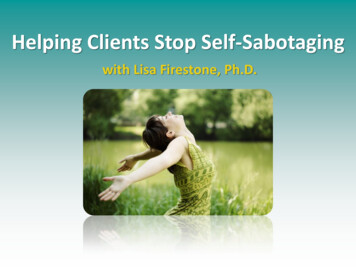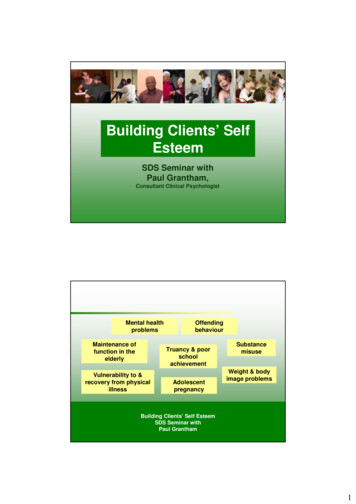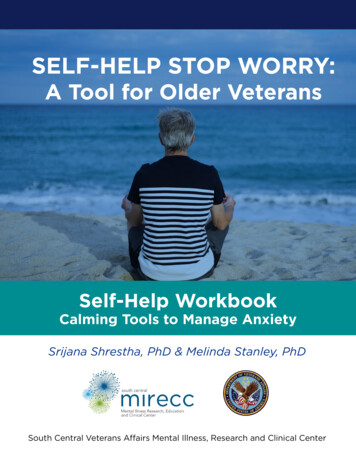
Transcription
Helping Clients Stop Self-Sabotagingwith Lisa Firestone, Ph.D.
Lisa Firestone, Ph.D.Director of Research and EducationThe Glendon AssociationSenior EditorPsychAlive.org(For Professionals)www.glendon.org(For the Public)www.psychalive.org
Poll #1:In what areas does self-sabotageaffect your clients?-WorkSchoolRelationshipsPersonal GoalsFamily Life
Self-Sabotage at Work A 2007 study showed that how people view their abilities in theworkplace impacts their success. People who thought of theirabilities as fixed were more likely to become anxious anddisoriented, causing their performance to suffer. A study from the Bureau of Labor Statistics showed that apositive self-image was strongly correlated with overall careersatisfaction, higher pay and better health.
Self-Sabotage in Relationships According to the American Psychological Association,about half of U.S. marriages end in divorce. According to data collected by WotWentWrong, an appthat tracks why people break up, the most commonreason for splits in couples who’d dated longer than sixmonths was “too much fighting.”
Self-Sabotage and Addiction“Giving up smoking is the easiest thing in the world. I knowbecause I've done it thousands of times.”- Mark Twain 90 percent of people who lose a lot of weight gain it back. 60 to 90 percent of smokers trying to quit relapse within thefirst year.
The Prevalence of Procrastination Procrastination has quadrupled in the past 30 years. 85-95 percent of students have problems associated withprocrastination. A 10-year study released in 2007 showed that procrastinationmakes people “poorer, fatter and unhappier.” 1 out of 5 people procrastinate so badly, it could jeopardizetheir jobs, relationships and health.
The Unconscious Fear of SuccessOgilvie’s five observations of why athletes may have“success phobia:”1.2.3.4.Social and emotional isolationGuilt over asserting themselves in competitionFear of discovering their true potentialAnxiety about the possibility of surpassing a previous recordestablished by an admired performer5. Pressure of constantly having to match or exceed one’sprevious best performance
The Unconscious Fear of SuccessOur observations of why people limit themselves:1. Fear of challenging one’s critical inner voice2. Fear of breaking a “fantasy bond”3. Fear of existential issues4. Fear of surpassing one’s parents/ breaking with family norms
Definition of the VoiceThe critical inner voice refers to a well-integrated pattern of destructivethoughts toward our selves and others. The “voices” that make up thisinternalized dialogue are at the root of much of our maladaptive behavior.This internal enemy fosters inwardness, distrust, self-criticism, self-denial,addictions and a retreat from goal-directed activities. The critical innervoice effects every aspect of our lives: our self-esteem and confidence,our personal and intimate relationships, and our performance andaccomplishments at school and work.
Common Critical Inner VoicesAbout Yourself:You’re ugly.You’re stupid.You’re not like other people.You’ll never succeed, so why even try?About Your Career:You’ll never be successful.No one appreciates how hard you work.You are under too much pressure; you can’thandle this stress.About Your Relationship:He doesn’t really care about you.You’re better off on your own.Don’t be vulnerable, you’ll just get hurt.
Poll #2:Do your clients commonly expresshaving these critical inner voices?-OftenSometimesRarelyNever
Part One:Where Do Critical Inner Voices Come From?
How Voices Pass FromGeneration to Generation
Separation TheoryRobert W. Firestone, Ph.D. Integrates psychoanalytic and existential systems ofthought Two kinds of emotional pain: Interpersonal Existential The core conflict Defended versus undefended lifestyles Formation of defenses in childhood The concept of the Fantasy Bond The concept of the Critical Inner Voice
Attachment TheorySir John Bowlby, Ph.D.Harry Harlow, Ph.D.Rene Spitz, M.DMary Ainsworth, Ph.D.Mary Main, Ph.D.Adult Attachment Interview:predicts the baby’s attachment tothe parent with 80% accuracy beforethe baby is even bornErik Hesse, Ph.D.
Where do voices come from?Patterns of Attachment in ChildrenCategory of AttachmentParental Interactive Pattern Secure Emotionally available, perceptive, responsive Insecure – avoidant Emotionally unavailable, imperceptive,unresponsive and rejecting Insecure- anxious/ambivalent Insecure - disorganized Inconsistently available, perceptive and responsiveand intrusive Frightening, frightened, disorienting, alarming
Attachment Figures Low Risk Non-Clinical Populations Secure55-65% Ambivalent5-15% Avoidant20-30% Disorganized20-40% (Given a Best Fit Alternative) High Risk, Parentally maltreated Disorganized80%
The Brain in the Palm of Your HandDaniel Siegel, M.D. – Interpersonal Neurobiology
9 Important Functions of thePre-Frontal Cortex1.2.3.4.5.6.7.8.9.Body RegulationAttunementEmotional BalanceResponse FlexibilityEmpathySelf-Knowing Awareness (Insight)Fear ModulationIntuitionMorality
Division of the MindParental AmbivalenceParents both love and hate themselves and extendboth reactions to their productions, i.e., theirchildren.Parental NurturanceParental Rejection, Neglect Hostility
Prenatal InfluencesDisease Trauma24Substance Abuse/ Domestic Violence
itySex25
Self-SystemParental NurturanceUnique make-up of the individual (geneticpredisposition and temperament); harmoniousidentification and incorporation of parent’spositive attitudes and traits and parentspositive behaviors: attunement, affection,control, nurturance; and the effect of othernurturing experience and education on thematuring self-system resulting in a sense of selfand a greater degree of differentiation fromparents and early caretakers.26
Personal Attitudes/Goals/ConscienceRealistic, Positive AttitudesTowards SelfRealistic evaluation of talents,abilities, etc with generallypositive/ compassionate attitudetowards self and others.BehaviorGoalsNeeds, wants, search formeaning in lifeGoal DirectedBehaviorMoral PrinciplesActing withIntegrityEthical behaviortowards self and others
Anti-Self System Unique vulnerability: genetic predisposition and temperament Destructive parental behavior: misattunement, lack of affection, rejection,neglect, hostility, over permissiveness Other Factors: accidents, illnesses, traumatic separation, death anxietyThe Fantasy Bond (core defense) is aself-parenting process made up of twoelements: the helpless, needy child, andthe self-punishing, self-nurturingparent. Either aspect may be extendedto relationships. The degree of defenseis proportional to the amount ofdamage sustained while growing up.28
Anti-Self SystemSelf-Punishing Voice ProcessVoice ProcessBehaviors1. Critical thoughts toward selfVerbal self-attacks – a generallynegative attitude toward self andothers predisposing alienation2. Micro-suicidal injunctionsAddictive patterns. Self-punitivethoughts after indulging3. Suicidal injunctions – suicidalideationActions that jeopardize, such ascarelessness with one’s body,physical attacks on the self, andactual suicide
Anti–Self SystemSelf- Soothing Voice ProcessVoice Process1. Self Soothing Attitudes2. Aggrandizingthoughts toward self3. Suspicious paranoidthoughts towards others4. Micro-suicidalInjunctions5. Overtly ViolentthoughtsBehaviorsSelf-limiting or selfprotective lifestyles,InwardnessVerbal build up towardselfAlienation from others,destructive behaviortowards othersAddictive patterns.Thoughts luring theperson into indulgingAggressive actions, actualviolence
Part Two:Challenging the Critical Inner Voice
Helping Your Clients Identify TheirCritical Inner VoiceHelp Clients:1.2.3.4.Recognize the events that trigger their Critical Inner VoiceRecognize the specific outside criticisms that support their Critical InnerVoiceBecome aware of times they may be projecting their self-attacks ontoother peopleNotice changes in their mood
Identify Negative ThinkingAre you ? Filtering: You magnify the negative aspects of a situationand filter out all of the positive ones. Personalizing: When something bad occurs, youautomatically blame yourself. Catastrophizing: You automatically assume and anticipatethe worst. Polarizing: You see things only as either good or bad.There is no middle ground.Source: Mayo Clinic
Exercise 1.1:Visualizing the Real YouAll exercises from Conquer Your Critical Inner Voice My physical abilities: My positive qualities: My interests and activities: My long-term goals: My short-term goals: Where do I stand in relation to my goals?
Exercise 1.2:Your Critical Inner Voice Attacks Self-critical attacks as “I”statementsExample: “I don’t think I’m anattractive person.” Self-critical attacks as “you”statementsExample: “You’re notattractive.”
Exercise 1.3:Keeping a Journal:Your Critical Inner Voice/The Real You My critical inner voiceas “you” statementsExample: “You’re so stupid.” The real meas “I” statementsExample: “Sometimes I strugglewith work, but I catch on quicklyand then usually do a good job.”
Exercise 1.4:A Plan for Action Actions dictated by my critical inner voice Actions to take that reflect the real meExamples:“Have another piece of cake.”“You should just be on your own.”“You can’t trust anyone, so don’t get tooclose.”Examples:“I want to eat healthy and take care ofmyself.”“I don’t want to be isolated and will seek outfriends”“I want to stay vulnerable in my closerelationships.”
Exercise 2.1:Seeing Your Parents RealisticallyA. Describing Your Parents’ Traits and Behaviors1.Did you experience any long-term separations from your parent orparents during your childhood? Through death? Divorce? Illness? Ifso, describe your reactions at the time.2.What do you think your parents offered you that has been themost valuable to you in your adult life? Describe these traits,values, or ideals.3.What faults or weaknesses did you dislike in your parent orparents? Describe these traits.4.Were your parents strict or overly permissive in their discipline ofyou and your siblings? Describe an example of how theydisciplined you.
Exercise 2.1:Seeing Your Parents RealisticallyB. Your Parents’ Behaviors That May HaveCaused You Shame or GuiltMotherFatherYes NoYes NoAs a child, were you beaten or scolded in thepresence of others?Yes NoYes NoDid your parents show with words andgestures that they liked you?Yes NoYes NoDid you ever feel humiliated by things yourparents did or said in front of others?Yes NoYes NoDid your parents begrudge you things youneeded?
Poll #3:Do you use homework assignmentsas an adjunct to therapy?-YesNo
Assessment Instruments Firestone Assessment of Self-Destructive Thoughts (FAST)Firestone Assessment of Suicidal Intent (FASI)Firestone Assessment of Violent ThoughtsFirestone Assessment of Violent Thoughts - Adolescents
Voice TherapyCognitive Affective Behavioral Approach
The Therapeutic Processin Voice TherapyStep IIdentify the content of the person’s negativethought process. The person is taught to articulatehis or her self-attacks in the second person. Theperson is encouraged to say the attack as he or shehears it or experiences it. If the person is holdingback feelings, he or she is encouraged to expressthem.Step IIThe person discusses insights and reactions toverbalizing the voice. The person attempts tounderstand the relationship between voice attacksand early life experience.
The Therapeutic Processin Voice TherapyStep IIIThe person answers back to the voice attacks, whichis often a cathartic experience. Afterwards, it isimportant for the person to make a rationalstatement about how he or she really is, how otherpeople really are, what is true about his or her socialworld.Step IVThe person develops insight about how the voiceattacks are influencing his or her present-daybehaviors.Step VThe person then collaborates with the therapist toplan changes in these behaviors. The person isencouraged to not engage in self-destructive behaviordictated by his or her negative thoughts and to alsoincrease the positive behaviors these negativethoughts discourage.If you are interested in attending a voice therapy training or in getting training materials please contactjina@glendon.org or visit www.glendon.org.
SelfAnti-Self
Reactions to Change Fear of the unknown or unfamilar Anxiety over living free from your inner critic Guilt over surpassing people from your past Sadness about the preciousness of life
CuriousOpenAcceptingLoving
Self-Compassion Vs. Self-EsteemResearch from Dr. Kristin Neff:Self-Esteem Self-esteem refers to our sense of self-worth, perceivedvalue or how much we like ourselves. Low self-esteem is problematic, however trying to havehigher self-esteem can also be problematic. The need for high self-esteem may encourage us to ignore,distort or hide personal shortcomings so that we can’t seeourselves accurately. Our self-esteem is often contingent on our latest success orfailure, meaning that our self-esteem fluctuates.SOURCE: http://www.self-compassion.org/
Self-Compassion Vs. Self-EsteemResearch from Dr. Kristin Neff:Self-Compassion Self-compassion is not based on self-evaluations. People feel compassion for themselves, because all humanbeings deserve compassion and understanding, notbecause they possess some particular set of traits. Research indicates that in comparison to self-esteem, selfcompassion is associated with greater emotional resilience,more accurate self-concepts, more caring relationshipbehavior, as well as less narcissism and reactive anger.SOURCE: http://www.self-compassion.org/
Studies show that self-compassion has asignificant positive association with: HappinessOptimismPositive affectWisdomPersonal initiativeCuriosity and ess
HardinessIn 30 years of research, Hardiness Institute founder Dr.Salvatore Maddi found that what predicts how well wewill do in life, our relationships, careers, etc. isn't howmuch money we have or even how many obstacles weface; it's a matter of how hardy we are.
Three C’s of HardinessCommitmentControlChallenge
DifferentiationChild SelfReal SelfParent Self
Steps of DifferentiationStep 1: Break with internalized thought processes, i.e., critical, hostileattitudes toward self and othersStep 2: Separate from negative personality traits assimilated from one’sparentsStep 3: Relinquish patterns of defense formed as an adaptation to painfulevents in one’s childhoodStep 4: Develop one’s own values, ideals, and beliefs rather thanautomatically accepting those one has grown up with
Guidelines for ContinuedPersonal Development Be Aware of the Fear That Accompanies Change Realize That Psychological Pain is Valid Develop a More Realistic View of Your Parents Differentiation – Unlearn Old Behaviors, Learn New Behaviors Become More Aware of Specific Defenses Against Feeling Recognize the Value of Friendship Seek Your Own Personal Meaning in Life
Guidelines for Further Developinga Meaningful Life Practice Being Generous in All Your Relationships Become Aware of Existential Realities Develop a Spiritual Perspective and Appreciate the Mystery of Existence
We create the world we live in.
A human being is a part of a whole, called by us 'universe',a part limited in time and space. He experiences himself,his thoughts and feelings as something separated from therest. a kind of optical delusion of his consciousness. Thisdelusion is a kind of prison for us, restricting us to ourpersonal desires and to affection for a few persons nearestto us. Our task must be to free ourselves from this prisonby widening our circle of compassion to embrace all livingcreatures and the whole of nature in its beauty. Nobody isable to achieve this completely, but the striving for suchachievement is in itself a part of the liberation and afoundation for inner security."- Albert Einstein
Resources: BooksVisit www.psychalive.org for resource links
eCOURSEOvercome Your Inner Critic:How to Free Yourself from Imagined LimitationsA SIX-WEEK-ECOURSESTARTS SEP. 16, 2014Learn More or Register at:WWW.ECOURSE.PSYCHALIVE.ORG
Contact:glendon@glendon.org800-663-5281(For Professionals)www.glendon.org(For the Public)www.psychalive.org
To receive your CE’s for this Webinar:* Within 24 hours of completion of this Webinar, you will receive anemail with an evaluation form and post test for you to complete andreturn to the us within 10 days of viewing the presentation. Theseforms can be completed online. Instructions will be given in theemail you receive. Upon receiving your completed evaluation form,a CE certificate will be mailed to you.* A recording of this Webinar will also be available online. Thoseunable to attend this live Webinar may view the recording and readan accompanying assignment to receive 3 CE Units for 35. A link tothis recording will be sent to you as well.
to relationships. The degree of defense is proportional to the amount of damage sustained while growing up. Anti-Self System Self-Punishing Voice Process Voice Process 1. Criti










